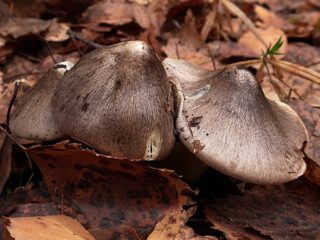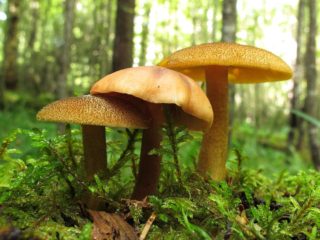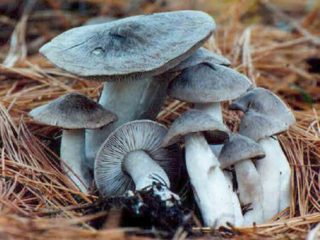Content
Silvery or yellowing, carved row is a conditionally edible mushroom that is easily confused with false representatives. That is why mushroom pickers often avoid it.
Where do silver rows grow?
Silver row (or Tricholoma scalpturatum) belongs to the Tricholoma family. Widely distributed in forests, parks, gardens, along roads and forest belts. The representative grows in large groups, so-called witch circles among the people. The whole colony is connected in a large circle.
You can find the fruiting body everywhere.In the Moscow region, fruiting begins in early summer and continues until mid-autumn. In the southern regions, mushrooms appear from the beginning of May and continue to grow until December.
What do silver rows look like?
The description states that the cap of the row is medium-sized silver. Its diameter is about 3-8 cm. In young specimens it is convex, later it becomes prostrate, but a characteristic tubercle remains in the center. The edges of the cap are uneven, wavy, and torn at the end. The skin is most often gray, but can be silver-brown. Overripe specimens are sometimes covered with yellowish spots.
At the bottom of the cap you can see thick plates that grow together. In young mushrooms they are white, later they acquire a yellowing appearance.
The leg of the silver row is thin, reaches 4-6 cm in height. It is smooth, fibers and remnants of the bedspread are clearly visible on it. The color of the legs is white or grayish.
The pulp of the fruiting body is fragile, thin, with a characteristic mealy color and odor.
Is it possible to eat silver rows?
Silver row is considered a conditionally edible mushroom, which has many useful qualities. It is eaten after careful processing.
Taste qualities of silver row mushroom
The taste of silver row is very mediocre and even bitter, but this is easy to get rid of. Mushrooms can be pickled, pickled and boiled.
Benefits and harm to the body
The rows contain many useful substances:
- vitamins A, B, P;
- calcium;
- microelements;
- amino acids.
Thanks to this composition, fruiting bodies have a healing effect on the body, protecting it from fatigue, overwork, strengthening the walls of blood vessels, increasing immunity, and saturating the brain with nutrients.
Antibiotics are made from silver rows, which are often used to fight tuberculosis. Extracts and extracts from fruiting bodies have a beneficial effect on the condition of the liver, removing toxins and waste from the body. Used to treat skin diseases.
Dried silver rows are used in cosmetology. Powder from them is added to creams and lotions to care for oily or acne-prone skin.
Mushrooms can only cause harm if they are improperly prepared or abused. They cause digestive tract upset.
False doubles
Silver row is often confused with other members of the family:
- scaly;
- earthy gray;
- brindle.
From scaly rows can be distinguished by the characteristic color of the cap. Its flesh is dense, fleshy, and its stem is thick. The plates are spaced widely apart. Classified as edible.
Row hat earthy gray large, up to 7 cm in diameter. Painted in ash-gray, mouse color. The leg is thickened, with a characteristic coating. The pulp is thin and changes color when damaged. The mushroom is conditionally edible, but can cause rhabdomyolysis.
Tiger row – a poisonous representative, causing serious poisoning even in small quantities. You can distinguish it by its cap, which has a spherical shape and reaches 12 cm in diameter.The skin color is off-white with a bluish tint. Scales and flakes are clearly visible on the surface. The leg is long - up to 15 cm. The taste is not bitter, the flesh is gray, yellowish at the base.
Collection rules
Only young fruits that have not yet outgrown are collected. All specimens damaged and spoiled by pests are left in the forest. It's better not to take them.
They go for mushrooms after good rainfall. They need a lot of moisture to grow. In dry weather, the rows are not collected, as they are damaged by insects.
Use
Fresh fruit bodies are sorted and peeled, which can be easily removed with a knife. If they are not very dirty, you can simply rinse them under running water and remove only the darkened areas. There is no need to soak silver rows.
The fruits can be pickled, fried, salted, but they must be boiled first. To do this, take clean water into the pan, add salt 1 tbsp. l. per 1 kg. When the water boils, you need to put a little citric acid in it and add the mushrooms. Cook over low heat for about 20 minutes. At the end of cooking, add bay leaf, allspice and a few cloves. Place the finished product in a colander. Drain the broth; it will not be useful.
For further pickling, young mushrooms that were collected in the fall are used. They are the densest and most suitable for these purposes. The classic recipe uses:
- spices;
- currant leaves;
- horseradish;
- Bay leaf.
Mushrooms are stacked in layers, sprinkled with salt, spices and herbs. The last layer should be a layer of herbs. Place a weight on top of it and put the container in a cool place for 40-45 days.
Conclusion
Silver row may look like a poisonous mushroom, but it is not one. It is eaten and used in folk medicine.You just need to properly collect and prepare the fruiting body.












